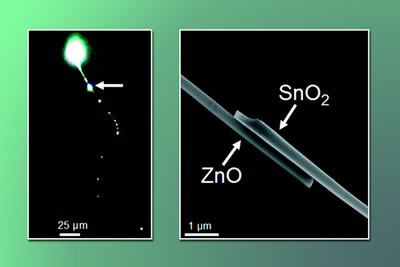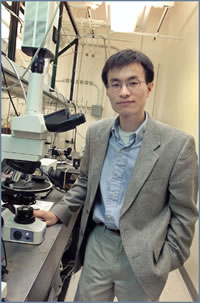| BERKELEY, CA — Another important
step towards realizing the promise of lightning fast photonic technology
has been taken by scientists with the U.S. Department of Energy's Lawrence
Berkeley National Laboratory (Berkeley Lab) and the University of California
at Berkeley. Researchers have demonstrated that semiconductor nanoribbons,
single crystals measuring tens of hundreds of microns in length, but only
a few hundred or less nanometers in width and thickness (about one ten-millionth
of an inch), can serve as "waveguides" for channeling and directing
the movement of light through circuitry.
|
|

|
 |
|
|
At left a zinc-oxide nanowire laser
is pumped with light, which is channeled into a tin-oxide nanoribbon
at a junction between the two materials and guided through the rest
of the ribbon's length. At right is an electron microscope image of
the junction between wire and ribbon.
|
|
|
|
"Not only have we shown that semiconductor nanoribbons can be used
as low-loss and highly flexible optical waveguides, we've also shown that
they have the potential to be integrated within other active optical components
to make photonic circuits," says Peidong Yang, a chemist with Berkeley
Lab's Materials Sciences Division and a professor with UC Berkeley's Chemistry
Department, who led this research.
The research results of Yang and his team are reported in the August 27,
2004 issue of the journal Science. Co-authoring the paper along
with Yang were Matt Law, Donald Sirbuly, Justin Johnson, Josh Goldberger
and Richard Saykally, all of whom are with affiliated with Berkeley Lab,
UC Berkeley, or both.
In photonic technology, or photonics, the use of electrons moving through
semiconductors as information carriers is replaced with the movement of
light waves, as measured in units of energy called photons. Whereas electrons
must carry information sequentially, one electron at a time, with photons
of light there's virtually no limit to the number of information packets
that can simultaneously be transmitted. Call it unparalleled parallel
processing.
Hints of the potential of photonics can be glimpsed in today's fiber-optic
communications, where a single optical fiber can carry the equivalent
of 300,000 telephone calls at the same time. But the power of fully realized
photonics goes far beyond this. For example, it's been estimated that
a photonic internet could transmit data at 160 gigabits per second, which
is thousands of times faster than today's typical high-speed connection.
Another possibility is the optical computer, which could solve problems
in seconds that would take today's electronic computers months or even
years to solve.
For the promise of photonics to be delivered, however, scientists must
first find a way to manipulate and route photons with the same dexterity
as they manipulate and route electrons. Whereas other research efforts
have successfully experimented with the use of photonic band-gap materials
to accomplish this, Yang and his colleagues have focused on the chemical
synthesis of nanowires and nanoribbons — they're like nanotubes only
solid throughout rather than hollow inside — that can then be assembled
into photonic circuits.
"Chemically synthesized nanowires and nanoribbons have several features
that make them good photonic building blocks," says Yang. "They
offer inherent one-dimensionality, a diversity of optical and electrical
properties, good size control, low surface roughness and, in principle,
the ability to operate above and below light-diffraction limits."
Yang and his colleagues synthesized their nanoribbon waveguides from tin
oxide, a semiconductor of keen technological interest for its exceptional
potential for use in transporting both photons and electrons in nanoscale
(also referred to as "subwavelength") components. The single
crystalline nanoribbons they produced measured about 1,500 microns in
length and featured a variety of widths and thicknesses. Yang says ribbons
that measured between 100 to 400 nanometers in width and thickness proved
to be ideal for guiding visible and ultraviolet light.
"To steer visible and ultraviolet light within dielectric waveguides,
such as the tin oxide crystals we were synthesizing, we needed to make
sure that a sufficient portion of the light's electromagnetic field was
confined within the nanostructures so there would be minimal optical transmission
loss," Yang says. "Considering the dielectric constant of the
tin oxide, it follows that the diameter of 100 to 400 nanometers would
be ideal for waveguiding light that measures from 300 to 800 nanometers
in wavelengths."
In their tests, Yang and his colleagues attached nanowire lasers and optical
detectors to opposite ends of their tin oxide nanoribbons, then demonstrated
that light could be propagated and modulated through subwavelength optical
cavities within the nanoribbons. The nanoribbons were long and strong
enough to be pushed, bent, and shaped with the use of a commercial micromanipulator
under an optical microscope. Freestanding ribbons were also extremely
flexible and could be curved through tight S-turns and twisted into a
variety of shapes, which Yang says is "remarkable for a crystal that
is brittle in its bulk form."
Yang also says that while the nanoribbon waveguides can be coupled together
to create optical networks that could serve as the basis of miniaturized
photonic circuitry, the ribbons need to be in close proximity, preferably
in direct physical contact, to enable an efficient transfer of light between
them.
"We tested various coupling geometries and found that a staggered
side-by-side arrangement, in which two ribbons interact over a distance
of several micrometers, outperforms direct end-to-end coupling,"
Yang says.
|
|
 |
 |
|
|
|
Peidong Yang, a chemist who holds
a joint appointment with Berkeley Lab and UC Berkeley, is one of the
leading developers of nanosized wires and ribbons. |
|
|
The nanoribbon waveguides that Yang and his co-authors report in their
Science paper are the newest addition to the growing assortment
of nanosized device elements that Yang and his research group have been
able to make. Their "toolbox" now includes nanoscale lasers
and photodetectors, in addition to the nanoribbon waveguides.
"Ultimately, we would like to integrate all these individual components
together into a photonic system-on-a-chip, so that many photonic operations,
including light emission, routing, and detection, can be done on a much
smaller scale," says Yang.
Berkeley Lab is a U.S. Department of Energy national laboratory located
in Berkeley, California. It conducts unclassified scientific research
and is managed by the University of California. Visit our website at www.lbl.gov/.
Additional information
|



